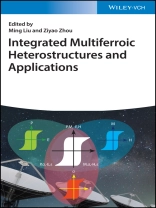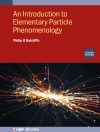Written by well-known experts in the field, this first systematic overview of multiferroic heterostructures summarizes the latest developments, first presenting the fundamental mechanisms, including multiferroic materials synthesis, structures and mechanisms, before going on to look at device applications.
The resulting text offers insight and understanding for scientists and students new to this area.
Inhoudsopgave
Preface ix
1 Introduction to Multiferroics and Its Application 1
Qu Yang, Bin Peng, Ziyao Zhou, and Ming Liu
1.1 Concept of Multiferroics and the Existing Magnetization Manipulation Methods for Practical Applications 1
1.2 Typical Multiferroic Heterostructures and Their Characteristics 2
References 2
2 Multiferroic Materials 5
Wanjun Peng, Ziyao Zhou, and Ming Liu
2.1 Introduction 5
2.2 Single-Phase Multiferroics 7
2.3 Bulk Composites 12
2.3.1 Ceramic Composites 13
2.3.2 Magnetic Alloy-Based Composites 15
2.3.3 Polymer-Based Composites 16
2.3.4 Converse ME Effect in Bulk Composites 18
2.4 Composite Thin Films 19
2.4.1 1-3 Type Columnar Composite Thin Films 20
2.4.2 0-3 Type Particle Composite Thin Films 22
2.4.3 2-2 Type Laminated Composite Thin Films 23
2.4.4 Quasi 2-2 Type Composite Thin Films 27
2.4.5 Organic Composite Thin Films 29
2.5 Two-Dimensional Multiferroics 32
References 36
3 Mechanisms of Multiferroic Material 51
Yuxin Cheng, Weixiao Hou, Mingmin Zhu, Bin Peng, Ziyao Zhou, and Ming Liu
Summary 51
3.1 Strain/Stress-Induced ME Coupling 51
3.2 EM-Spin-Wave Coupling 55
3.3 Interfacial Charge-Induced ME Coupling 65
3.4 BFO System 70
3.5 Spiral Spin Order Control RMn O3 94
3.6 Other Novel Interfacial ME Coupling Effects 100
References 109
4 Multiferroic Simulations 121
Yue-Wen Fang, Wen-Yi Tong, and Chun-Gang Duan
4.1 First-Principles Calculation 121
4.1.1 Origins of Ferroelectricity in Type-I Multiferroics 122
4.1.2 Conventional Ferroelectricity 123
4.1.3 ns2 Lone-Pair Stereochemical Activity 123
4.1.4 Geometric Ferroelectricity 124
4.1.5 Electronic Ferroelectricity 125
4.2 Spin-Driven Ferroelectricity in Type-II Multiferroic Materials 126
4.2.1 Ferroelectricity Induced by Noncollinear Magnetism 126
4.2.2 Ferroelectricity Induced by Collinear Magnetism 129
4.3 Prediction of Novel Multiferroics 130
4.3.1 Strain Engineering 130
4.3.2 Systems Based on Ordered Perovskite Cells 132
4.4 Phase-Field Simulation 134
4.4.1 Simulation of Ferroelectric Switching Properties 134
4.4.2 Ferroelectric Switching in Bi Fe O3 135
4.4.3 Ferroelectric Switching in Ba Ti O3/Sr Ti O3 Superlattice 137
4.5 Simulation of Coupled Ferroic Domains 139
4.5.1 Phase-Field Simulation in Magnetoelectric Composites 140
4.5.2 Phase-Field Simulation in Single-Phase Multiferroics 142
4.6 Theoretical Models of Magnetoelectric Coupling in Multiferroic Heterostructures 143
4.6.1 Interface Magnetoelectric Effect 144
4.6.2 Spin-Dependent Screening-Induced Magnetoelectric Effect 146
References 151
5 Multiferroic RF/Microwave Devices 157
Wanjun Peng, Brandon Howe, and Xi Yang
5.1 Voltage Control of FMR 157
5.1.1 Voltage Control of FMR via Strain/Stress 158
5.1.1.1 Strain/Stress Modulation for Materials with In-Plane Easy Axis 158
5.1.1.2 Strain/Stress Modulation for Materials with Out-of-Plane Easy Axis 159
5.1.2 Voltage Control of FMR via the Combined Effects of Strain/Stress and Other Mechanisms 160
5.1.2.1 Strain and Charge Co-Mediated FMR 160
5.1.2.2 Strain and Surface Spin Torque Co-Mediated FMR 160
5.2 Voltage Control of FMR via Ionic Liquid Gating 161
5.3 RF/Microwave Devices in General 163
5.4 State-of-the-Art Tunable RF/Microwave Devices 164
5.4.1 Magnetic and Magnetoelectric Inductors 164
5.4.2 Bandpass Filters and Bandstop Filters/Attenuators 164
5.4.3 Phase Shifters and Delay Lines 167
5.4.4 Multiferroic/Magnetoelectric Antennas 168
5.5 Multiferroic RF/Microwave Devices in Future 168
References 169
6 Toward Multiferroic Memories 175
Zhongqiang Hu, Qu Yang, Xinger Zhao, and Gail J. Brown
6.1 Introduction 175
6.2 Voltage Control of Magnetism 176
6.2.1 Voltage Control of Magnetoresistance 177
6.2.2 Voltage Control of Exchange Bias 177
6.2.3 Voltage Control of Domain Dynamics 184
6.2.4 Toward Nonvolatile Control of Magnetism 188
6.3 Magnetic Memories in General 189
6.4 State-of-the-Art Multiferroic Memories 191
6.5 Multiferroic Memories in Future 196
References 197
7 Multiferroic Sensors 203
Zhiguang Wang, Menghui Li, Tianxiang Nan, and Nianxiang Sun
7.1 Introduction 203
7.2 ME Coupling 203
7.3 Magnetic Sensors in General 204
7.4 State-of-the-Art Multiferroic Sensors 205
7.4.1 Highly Sensitive Bulk ME Sensor 206
7.4.2 Miniature Nanoelectromechanical Systems (NEMS) Sensor Based on Nanoplate Resonator 207
7.4.3 A Novel Flexible Sensor Based on AMR Effect 208
References 209
8 Integrated Multiferroic Inductors – Toward Reconfiguration 211
Yuan Gao, Tian Wang, Zhongqiang Hu, and Bin Peng
8.1 Introduction 211
8.2 Magnetic Inductors 211
8.2.1 Inductor Structures 211
8.2.2 Magnetic Materials 213
8.3 Tunable Multiferroic Inductors 217
8.3.1 Tunability for RFIC and MMIC 217
8.3.1.1 Ferroelectric Varactors 217
8.3.1.2 RF MEMS 219
8.3.1.3 FET Switches 220
8.3.1.4 Tunable Multiferroics 221
8.3.2 Tunability for Inductors 222
8.4 Recent Progress of Magnetic Inductors and Voltage Tunable Inductors 226
References 230
9 Multiferroics in Future 237
Qu Yang, Bin Peng, Ziyao Zhou, and Ming Liu
9.1 Novel Multiferroic Devices and Applications 237
9.1.1 Magnetoelectric Recording 237
9.1.2 Magnetoelectric Random Access Memories 238
9.1.3 Electrically Tunable Microwave Devices 238
9.2 Novel Multiferroic Composites 239
9.2.1 Exchange Bias 239
9.2.2 Spin Wave 239
References 239
Index 243
Over de auteur
Dr. Ming Liu is Professor at the School of Electrical and Information Engineering, and Director of the laboratory for Integrated Multiferroic Materials and Devices at Xi’an Jiaotong University, China. He obtained his Ph D from Northeastern University, USA in 2010. His research is focused on integrated multiferroics and device applications. He has contributed more than 130 scientific publications. One of the first-authored paper was selected as ’the 10 most outstanding full papers in the past ten years 7(2001~2010) in Advanced Functional Materials’.
Dr. Ziyao Zhou is Professor at the School of Electrical and Information Engineering, and Director of the laboratory for Integrated Multiferroic Materials and Devices at ‘an Jiaotong University, China. He received his Ph D from Electrical and Computer Engineering department at Northeastern University, USA. His research has been on integrated nanostructures and multiferroics for energy-efficient electronics and spintronics. He has contributed to a number of publications and related patents and patent disclosures.












